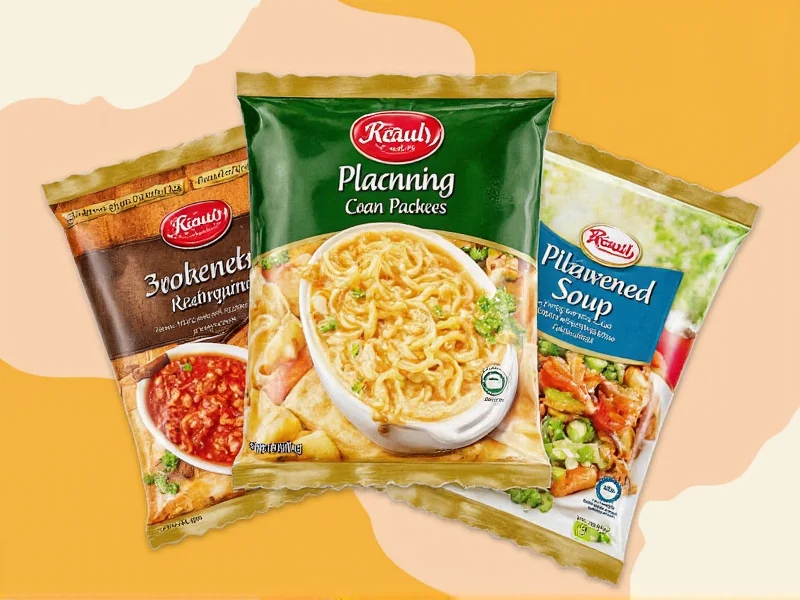Understanding Soup Packets: More Than Just Instant Soup
Soup packets represent one of the most versatile pantry staples available to home cooks. These compact flavor concentrates have evolved significantly since their introduction in the mid-20th century, offering convenience without sacrificing too much on taste or nutrition. Unlike canned soups that require preservatives for shelf stability, soup packets use dehydration and concentration techniques to preserve flavor while minimizing space.
Types of Soup Packets Available
Modern soup packets fall into several distinct categories based on their composition and intended use:
| Type | Composition | Best Uses | Shelf Life |
|---|---|---|---|
| Powdered Broth Bases | Dehydrated vegetables, salt, seasonings | Basic soups, cooking grains, deglazing pans | 18-24 months |
| Cream Soup Mixes | Dehydrated dairy, starches, seasonings | Casseroles, sauces, creamy soups | 12-18 months |
| Liquid Concentrates | Reduced broth, minimal preservatives | Restaurant-style soups, delicate dishes | 6-12 months (unopened) |
| Specialty Flavor Packets | Region-specific spices and ingredients | Authentic ethnic dishes, flavor experimentation | 12 months |
Nutritional Profile and Considerations
When evaluating the nutritional value of soup packets, sodium content represents the primary concern for health-conscious consumers. Most standard packets contain 700-900mg of sodium per serving, which constitutes nearly half the recommended daily limit. However, low-sodium options have become increasingly available, typically containing 300-400mg per serving.
From a nutritional standpoint, soup packets generally provide minimal protein and fiber but can contribute small amounts of vitamins from dehydrated vegetables. The real nutritional value comes from what home cooks add to the base—fresh vegetables, lean proteins, and whole grains transform a simple packet into a balanced meal. Understanding how to use soup packets in cooking means recognizing their role as flavor foundations rather than complete nutritional solutions.
Creative Applications Beyond Basic Soup
Experienced home cooks know the best ways to enhance soup packet flavor extend far beyond simply adding water. Consider these professional techniques:
- Grain Cooking Liquid: Replace water with broth when preparing rice, quinoa, or couscous using a reduced amount of soup packet for subtle flavor enhancement
- Sauce Base: Whisk one packet with 2 cups of milk for instant creamy sauces that work perfectly for casseroles or pasta dishes
- Meat Tenderizer: Dissolve a packet in water and use as a brine for chicken or pork before roasting
- Flavor Boost for Slow Cooker Meals: Add half a packet to bean dishes or stews for depth without excessive saltiness
- Vegetable Seasoning: Sprinkle powder directly onto roasted vegetables during the last 10 minutes of cooking
Storage Guidelines and Shelf Life
Proper storage significantly impacts the quality and safety of soup packets. Store unopened packets in a cool, dark pantry away from heat sources and moisture. Once opened, transfer contents to an airtight container and use within 2-3 weeks for best flavor. While most packets remain safe well past their printed date, flavor degradation becomes noticeable after 6 months beyond expiration.
Signs that soup packets have spoiled include clumping (in powdered varieties), discoloration, or off odors. Liquid concentrates may develop mold or separation that doesn't resolve with stirring. When in doubt about comparing soup packets to canned soup for freshness, remember that packets generally maintain quality longer due to their dehydrated state.
Maximizing Flavor and Nutrition
Transforming a basic soup packet into a restaurant-quality dish requires just a few simple additions. Start by sautéing fresh aromatics like onions, garlic, and celery before adding the packet and water. For cream-based soups, substitute half the water with milk or cream for richer texture. Boost nutritional value by adding frozen vegetables, canned beans (rinsed to reduce sodium), or shredded cooked chicken.
Those seeking low sodium soup packet options can dilute regular packets with extra water and compensate with fresh herbs, lemon juice, or vinegar. Creating homemade soup with soup packets becomes truly special when finished with a drizzle of good olive oil or a sprinkle of fresh herbs just before serving.
Frequently Asked Questions
Can I use soup packets after the expiration date?
Yes, most unopened soup packets remain safe to consume 6-12 months past their printed date when stored properly in a cool, dry place. While flavor may diminish over time, they don't typically become unsafe unless showing signs of moisture damage, mold, or significant discoloration.
How can I reduce the sodium content in soup packets?
To reduce sodium, use only half a packet and supplement with additional herbs, spices, lemon juice, or vinegar for flavor. You can also dilute the packet with extra water or unsalted broth. Many brands now offer specifically labeled low-sodium versions that contain 30-50% less salt than regular varieties.
What's the difference between soup packets and bouillon cubes?
Soup packets typically contain additional ingredients like starches, dehydrated vegetables, and seasonings beyond just broth concentrate, creating a more complete soup base. Bouillon cubes are primarily concentrated broth with salt and fat, requiring additional ingredients to make a complete soup. Packets generally dissolve more quickly in liquid than cubes.
Can I make vegetarian soup using meat-flavored packets?
Most chicken or beef flavored soup packets contain actual meat derivatives or animal-based ingredients. For vegetarian cooking, look for specifically labeled vegetable, mushroom, or miso-based packets. Many brands now offer plant-based alternatives that provide similar umami flavor without animal products.
How do I prevent lumps when using cream soup packets?
To prevent lumps, create a slurry by mixing the packet contents with a small amount of cold liquid before adding to hot liquid. Alternatively, whisk constantly while gradually pouring the packet into simmering liquid. For best results with cream of mushroom or chicken packets, use milk instead of water and maintain a gentle simmer rather than a rolling boil.











 浙公网安备
33010002000092号
浙公网安备
33010002000092号 浙B2-20120091-4
浙B2-20120091-4